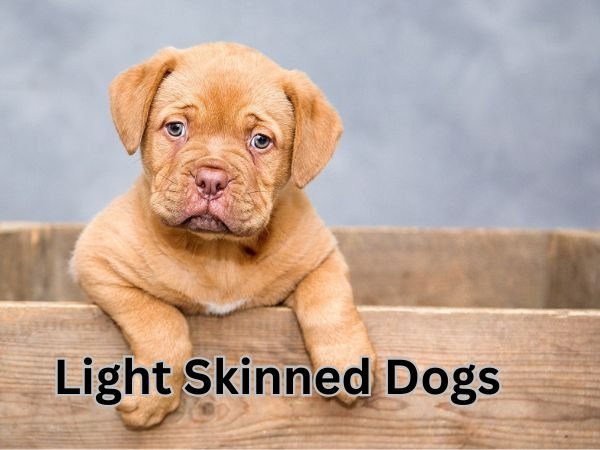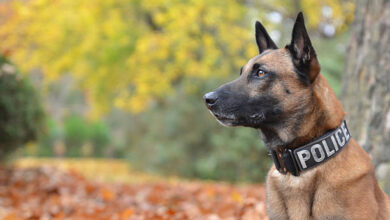
Have you ever wondered why certain dogs seem to glow with an almost angelic presence? Light skinned dogs – name of a beautiful breeds with their pristine white coats, creamy fur, and pale, delicate skin that seems to shimmer in the sunlight. From the tiniest lap dogs with silky white coats to majestic larger breeds sporting cream and pale coloring, light-colored canines bring a unique charm to any home. Their unique beauty often makes them look like living stuffed animals, but they are not only beautiful but also they are very good and friendly dog – these dogs are just as spirited and loving as any other breed.
So, in this article we are going to introduce you the 7 absolutely adorable light-skinned breeds that will have you reaching for your phone to call the nearest breeder. Trust us, by the end of this list, your heart will be completely melted!
Why Light Skinned Dogs Are Special
Light skinned dogs have an almost magical quality that sets them apart. Picture a fluffy white Samoyed with its signature “smile” or a graceful Maltese with silky locks flowing in the breeze – these pups look like they stepped out of a fairy tale! Their pale coats create a stunning canvas that highlights their expressive eyes and adorable features.
Historical Significance in Breeding
These beautiful breeds weren’t accidents. Breeders carefully developed many light-coated dogs for specific purposes:
- Arctic breeds like Samoyeds needed light coats for camouflage in snow
- Royal companions such as Maltese were prized by nobility for their elegant appearance
- Working dogs like Great Pyrenees used their white coats to blend with sheep flocks
Popular Misconceptions Addressed
Let’s clear up some myths about our pale-coated friends:
- “They’re high-maintenance” – While they need regular grooming, it’s totally manageable
- “They’re fragile” – Many light skinned dogs are actually quite sturdy and athletic
- “They get dirty easily” – Yes, but regular brushing keeps them looking pristine
These special pups bring joy and elegance to any family lucky enough to have them!
7 Most Adorable Light Skinned Dogs
1.Bichon Frise – “The Fluffy Cloud Dog”
The Bichon Frise looks exactly like a living, breathing cotton ball that somehow learned to walk and wag its tail. These light skinned dogs sport a double-layered coat that’s impossibly soft and curly, creating that signature “powder puff” appearance. Their dark, round eyes peek out from their fluffy white face like little buttons, while their black nose and lips create a charming contrast against their pristine coat.
Standing small but proud, Bichons have a compact, sturdy build that’s perfectly proportioned. Their tail curls gracefully over their back, and their ears hang down in soft, feathery triangles that frame their sweet face beautifully.
Temperament
Bichons are the ultimate people-pleasers with hearts as big as their fluffy coats. These dogs practically bounce with joy when meeting new friends – both human and canine. They’re:
- Incredibly social and thrive on human companionship
- Gentle and patient with children of all ages
- Moderately energetic – perfect for active families but not overwhelming
- Intelligent and eager to learn new tricks
Why They’re Adorable
What’s not to love about a dog that looks like it was designed by someone who thought, “Let’s make the cutest thing possible”? Bichons have this magical ability to make you smile just by existing. Their bouncy walk resembles a happy little cloud floating across your living room. When they get excited, their entire body seems to wiggle with pure joy, and their “Bichon blitz” – those sudden bursts of playful energy – will have you laughing every time.
Quick Stats Box
- Height: 9-12 inches
- Weight: 12-18 pounds
- Lifespan: 14-15 years
- Temperament: Cheerful, playful, gentle
- Energy Level: Moderate
- Good with Kids: Excellent
Care Highlights
- Daily brushing prevents matting and keeps that cloud-like fluffiness
- Professional grooming every 4-6 weeks maintains their signature look
- Regular eye cleaning prevents tear stains on their white coat
- Moderate exercise needs – daily walks and playtime keep them happy
- Watch for allergies – some Bichons have sensitive skin that needs gentle care
2.Maltese – “The Silky Companion”
The Maltese is a tiny bundle of pure elegance wrapped in a gorgeous silky white coat. These little beauties typically weigh between 4-7 pounds and stand just 7-9 inches tall – perfect for cuddling on your lap! Their most striking feature is their floor-length, straight white hair that flows like silk when they move. With their black button nose and dark, expressive eyes that seem to sparkle with mischief, they look like living dolls.
Their compact body and confident stride make them appear much larger than they actually are. Many owners love to style their hair in a cute topknot, which gives them an even more adorable appearance.
Temperament
Don’t let their small size fool you – Maltese dogs have big personalities! These little charmers are:
- Fearless and confident despite their tiny stature
- Extremely loyal to their family members
- Playful and energetic with moderate exercise needs
- Gentle with children when properly socialized
- Alert watchdogs who’ll bark to let you know someone’s at the door
They’re perfect for apartment living and make excellent companions for seniors or families looking for a loving lap dog.
Why They’re Adorable
What makes Maltese dogs absolutely irresistible? Here’s what melts hearts:
- Their bouncy, graceful walk that looks like they’re floating
- The way they tilt their heads when listening to you talk
- Their playful antics that keep you entertained for hours
- How they follow you everywhere like a devoted shadow
- Their gentle snoring when curled up on your chest
- The pure joy they show when you come home
Quick Stats
- Height: 7-9 inches
- Weight: 4-7 pounds
- Lifespan: 12-15 years
- Temperament: Gentle, playful, fearless, affectionate
- Energy Level: Moderate
- Good with Kids: Yes, with supervision
- Apartment Friendly: Excellent choice
Care Highlights
Grooming Needs
- Daily brushing is essential to prevent matting
- Professional grooming every 4-6 weeks
- Regular eye cleaning to prevent tear stains
- Weekly baths to keep their white coat pristine
Health Notes
- Luxating patella (kneecap dislocation) is common
- Dental care is crucial due to their small mouths
- Hypoglycemia can affect puppies – monitor eating habits
- Regular vet checkups help catch issues early
These precious companions require dedication to grooming, but the love and joy they bring make every brushing session worth it!
3.West Highland White Terrier – “The Spirited Scotsman”
The West Highland White Terrier is a small but sturdy dog that looks like a living cotton ball with attitude. These compact pups stand proudly with their signature double coat that’s always pristine white. Their dark, almond-shaped eyes sparkle with mischief, while their pointed ears stand at attention like tiny radar dishes. Don’t let their size fool you – these dogs are built tough with a strong, muscular body that’s perfectly balanced for adventure.
Temperament
Family-Friendly Traits:
- Excellent with children who respect their boundaries
- Loyal and devoted to their human pack
- Naturally protective without being aggressive
- Adapts well to apartment or house living
Energy Level:
- High energy bursts followed by cozy nap times
- Loves daily walks and play sessions
- Enjoys mental challenges and puzzle games
- Can be satisfied with 30-45 minutes of daily exercise
Why They’re Adorable
Westies have this amazing ability to look dignified one moment and absolutely goofy the next. Their confident strut makes them seem like they own the neighborhood, while their playful antics will have you laughing daily. They’re like tiny comedians who don’t know they’re funny – whether they’re “helping” you garden by digging enthusiastic holes or giving you those irresistible head tilts when you talk to them.
Quick Stats Box
- Height: 10-11 inches
- Weight: 15-20 pounds
- Lifespan: 12-16 years
- Temperament: Confident, friendly, hardy
Care Highlights
Grooming Needs:
- Brush 2-3 times weekly to prevent matting
- Professional grooming every 6-8 weeks
- Regular nail trims and ear cleaning
Health Notes:
- Generally healthy breed with few major concerns
- Watch for skin allergies (common in white-coated dogs)
- Regular dental care important for small breeds
4.Shih Tzu – “The Royal Lap Dog”
The Shih Tzu is a compact little charmer with a sturdy build wrapped in gorgeous flowing hair. These pups sport a distinctive double coat that feels like silk between your fingers. Their most striking feature? Those large, round dark eyes that seem to sparkle with mischief and love. With their pushed-in face and black button nose, they look like living teddy bears.
Their coat comes in beautiful light shades including:
- Pure white
- Cream and white combinations
- Light gold and white
- Silver and white patterns
Temperament
Don’t let their royal appearance fool you – Shih Tzus are wonderfully friendly family dogs! They’re like that perfect house guest who gets along with everyone.
- Great with kids – patient and gentle
- Moderate energy – happy with daily walks and playtime
- Social butterflies – love meeting new people and pets
- Calm indoors – perfect apartment companions
Why They’re Adorable
Shih Tzus have this magical way of making you smile every single day. Their flowing hair bounces when they trot, making them look like they’re floating. They have this adorable habit of sitting like little humans, with perfect posture that screams “I’m royalty!”
Their expressive eyes seem to understand exactly what you’re thinking, and they’ll tilt their head in the cutest way when you talk to them.
Quick Stats
- Height: 9-11 inches
- Weight: 9-16 pounds
- Lifespan: 10-18 years
- Temperament: Friendly, outgoing, affectionate
Care Highlights
Grooming needs: Daily brushing is essential to prevent matting – think of it as bonding time! Many owners opt for a shorter “puppy cut” to make maintenance easier.
Health watch: Keep those beautiful eyes clean and watch for breathing issues due to their flat face. Regular vet checkups help catch any problems early.
5.Cocker Spaniel – “The Gentle Family Friend”
Cocker Spaniels are medium-sized beauties that perfectly balance elegance and warmth. These gorgeous pups typically stand 13-15 inches tall and weigh between 20-30 pounds. Their most striking feature? That silky, flowing coat that comes in beautiful light colors like cream, buff, and golden blonde.
Their expressive eyes are truly captivating – large, dark, and filled with intelligence. Those famous long, feathered ears frame their sweet faces perfectly, giving them that classic “puppy dog look” that melts hearts instantly.
Temperament
Family-Friendly Traits
- Gentle with children – naturally patient and protective
- Eager to please – loves making their family happy
- Social butterflies – gets along well with other pets
- Loyal companions – forms strong bonds with family members
Energy Level
Cocker Spaniels have moderate energy that’s perfect for most families. They love daily walks, playing fetch in the backyard, and cozy cuddle sessions on the couch. Think of them as your ideal adventure buddy who’s equally happy hiking or Netflix binging.
Why They’re Adorable
There’s something magical about a Cocker Spaniel’s tail-wagging enthusiasm when you walk through the door. They have this incredible ability to sense your mood – offering gentle comfort when you’re down and matching your excitement when you’re happy.
Their soft, flowing coat begs to be petted, and they absolutely love the attention. Plus, that signature Cocker Spaniel smile? It’s guaranteed to brighten even your toughest days.
Quick Stats Box
- Height: 13-15 inches
- Weight: 20-30 pounds
- Lifespan: 12-15 years
- Temperament: Gentle, friendly, intelligent, eager-to-please
Care Highlights
Grooming Needs
- Daily brushing prevents matting in their beautiful coat
- Professional grooming every 6-8 weeks keeps them looking their best
- Regular ear cleaning is essential due to their long, floppy ears
Health Notes
- Watch for ear infections – their covered ears can trap moisture
- Eye care is important to prevent issues common in the breed
- Regular exercise helps maintain their ideal weight and happy disposition
6.Pomeranian – “The Tiny Fluffball”
The Pomeranian is like carrying around a living teddy bear! These light skinned dogs are incredibly small, weighing just 3-7 pounds and standing 6-7 inches tall. Their double coat is their crown jewel – thick, fluffy, and oh-so-soft to touch. Light-colored Poms come in beautiful shades of:
- Cream – like vanilla ice cream
- White – pure as fresh snow
- Orange sable – peachy perfection
- Light orange – sunset hues
Their fox-like face features bright, alert eyes and a tiny black nose that’s just begging for boops!
Temperament
Don’t let their size fool you – Pomeranians have big dog energy packed into a tiny body! They’re:
- Confident and outgoing
- Playful with endless enthusiasm
- Loyal to their favorite humans
- Alert watchdogs (yes, really!)
- Social when properly introduced
Perfect for families who want a small companion that thinks it’s a German Shepherd!
Why They’re Adorable
Everything about Pomeranians screams “adorable”:
- That fluffy coat that bounces when they walk
- Their tiny paws that patter across the floor
- The way they strut like they own the world
- Their expressive faces that show every emotion
- How they demand attention with the cutest little barks
Quick Stats Box
- Height: 6-7 inches
- Weight: 3-7 pounds
- Lifespan: 12-16 years
- Temperament: Lively, bold, inquisitive
Care Highlights
Grooming Needs:
- Daily brushing to prevent matting
- Professional grooming every 6-8 weeks
- Regular nail trims (those tiny nails grow fast!)
Health Watch:
- Keep an eye on their delicate trachea
- Monitor for luxating patella (kneecap dislocation)
- Protect from extreme temperatures due to their size
7.Great Pyrenees – “The Gentle Giant”
The Great Pyrenees is a breathtaking sight to behold. These majestic dogs stand tall and proud, with males reaching up to 32 inches at the shoulder. Their thick, weather-resistant double coat comes in stunning shades of white, often with subtle cream or light gray markings around the ears and face.
Key Features:
- Massive size with a sturdy, well-balanced build
- Fluffy, dense coat that feels like touching a cloud
- Dark, expressive eyes that seem to see into your soul
- Distinctive dewclaws on their back legs
- Feathered tail that curls over their back like a plume
Temperament
Don’t let their size fool you – these gentle giants are incredibly calm and patient. Originally bred to guard sheep in the Pyrenees Mountains, they have a natural protective instinct balanced with remarkable gentleness around family members.
Family-Friendly Traits:
- Patient with children – they’re like living teddy bears
- Calm energy level – perfect couch companions
- Naturally protective without being aggressive
- Independent thinkers who don’t need constant attention
- Loyal to their family but can be reserved with strangers
Why They’re Adorable
There’s something magical about watching Great Pyrenees interact with their family. These fluffy protectors will gently nudge you with their massive heads for attention, then settle down beside you like a warm, breathing pillow. Their serious expression melts away when they’re playing, revealing a surprisingly playful side that’s absolutely heartwarming.
Their “Pyr paw” – the way they gently place their enormous paw on you for attention – is legendary among owners. It’s impossible not to smile when a 100-pound dog acts like a lap dog!
Quick Stats
- Height: 25-32 inches
- Weight: 85-160 pounds
- Lifespan: 10-12 years
- Temperament: Gentle, patient, protective, independent
Care Highlights
Grooming Needs:
- Daily brushing during shedding season (twice yearly)
- Weekly brushing the rest of the year
- Regular nail trims – those big paws need attention
- Ear cleaning to prevent infections in those fluffy ears
Health Considerations:
- Watch for hip dysplasia – common in large breeds
- Bloat prevention – feed smaller, frequent meals
- Heat sensitivity – that thick coat means they prefer cooler weather
- Regular exercise but nothing too intense – they’re not marathon runners.
Caring for Light Skinned Dogs
Sun Protection: UV Sensitivity and Sunburn Prevention
Just like fair-skinned humans, light skinned dogs need extra protection from the sun’s harmful rays. Their pale skin is more vulnerable to UV damage, especially around the nose, ears, and belly areas.
- Apply pet-safe sunscreen to exposed skin areas before outdoor activities
- Limit midday walks when the sun is strongest (10 AM – 4 PM)
- Provide shaded areas in your yard for cooling off
- Consider UV-protective clothing for extended outdoor time
Think of your white-coated pup like a redhead at the beach – they burn faster and need more protection!
Grooming Essentials: Special Shampoos for White Coats
Keeping that pristine coat looking its best requires the right products and techniques.
- Use whitening shampoos specifically formulated for light coats
- Bathe regularly (every 2-3 weeks) to prevent yellowing
- Brush daily to remove dirt before it stains the fur
- Dry thoroughly after baths to prevent skin issues
Health Considerations: Regular Vet Checkups
Light skinned dogs may face unique health challenges that require monitoring.
- Schedule regular skin checks for moles or suspicious spots
- Discuss sun exposure with your vet
- Monitor for hearing issues (common in some white breeds)
- Stay current on vaccinations and preventive care
Choosing the Right Light Skinned Dog for Your Family
Consider Your Lifestyle: Activity Level Matching
Before falling in love with those adorable white pups, honestly assess your daily routine.
- High-energy breeds like West Highland Terriers need active families who enjoy long walks and playtime
- Calm lap dogs like Maltese are perfect for quieter households
- Working breeds require mental stimulation and job-like activities
- Consider your work schedule – some breeds need more attention than others
Space Requirements: Apartment vs. House Considerations
Not all light skinned dogs need the same living space.
- Small breeds (Bichon Frise, Havanese) thrive in apartments with daily walks
- Medium breeds (Cocker Spaniels) need moderate space and regular exercise
- Large breeds (Great Pyrenees, Samoyeds) require yards and more room to roam
- Think about grooming space – fluffy coats need regular brushing areas
Family Dynamics: Dogs Good with Children
Light skinned dogs can make wonderful family pets when matched correctly.
- Gentle giants like Great Pyrenees are patient with kids
- Playful breeds such as Bichons love interactive family time
- Consider the dog’s size relative to your children’s ages
- Some breeds are better with older children who understand gentle handling
Conclusion
Choosing a light skinned dog means embracing both their stunning beauty and unique care needs. These special pups require extra attention to sun protection, specialized grooming, and regular health monitoring. However, the reward is a devoted companion whose angelic appearance matches their loving personality. Take time to honestly evaluate your lifestyle, space, and commitment level before bringing home your perfect light-coated friend. With proper care and attention, your light skinned dog will be a cherished family member for years to come.
FAQ
What are light skinned dogs?
Light skinned dogs are breeds with pale coats, such as cream, white, or light tan. Popular examples include Golden Retrievers, Samoyeds, and Labrador mixes. These dogs often have a soft, gentle look that makes them stand out and look extra adorable.
Which dog breeds have light skin or coats?
Common light skinned dog breeds include Golden Retrievers, Labrador Retrievers, Samoyeds, Maltese, Poodles, and Shih Tzus. Many mixed breeds also come in lighter shades, giving them a unique, lovable appearance. Their pale coats often make them look soft, fluffy, and very photogenic.
Are light skinned dogs good family pets?
Yes, many light skinned dogs are great family pets. Breeds like Golden Retrievers and Labradors are friendly, playful, and gentle with kids. Smaller breeds like Maltese or Shih Tzus are also affectionate companions. Their loving nature makes them perfect for homes with children or other pets.
Do light skinned dogs need special care?
Light skinned dogs may need extra grooming and sun protection. Their lighter coats can show dirt more easily, so regular brushing helps. In sunny areas, some may need pet-safe sunscreen on sensitive skin like the nose or ears to prevent sunburn.
Why do people love light skinned dogs?
People love light skinned dogs because they look soft, fluffy, and very cute. Their pale coats often give them a gentle and sweet appearance. Many of these breeds are also known for their affectionate nature, making them both beautiful and loving companions.



